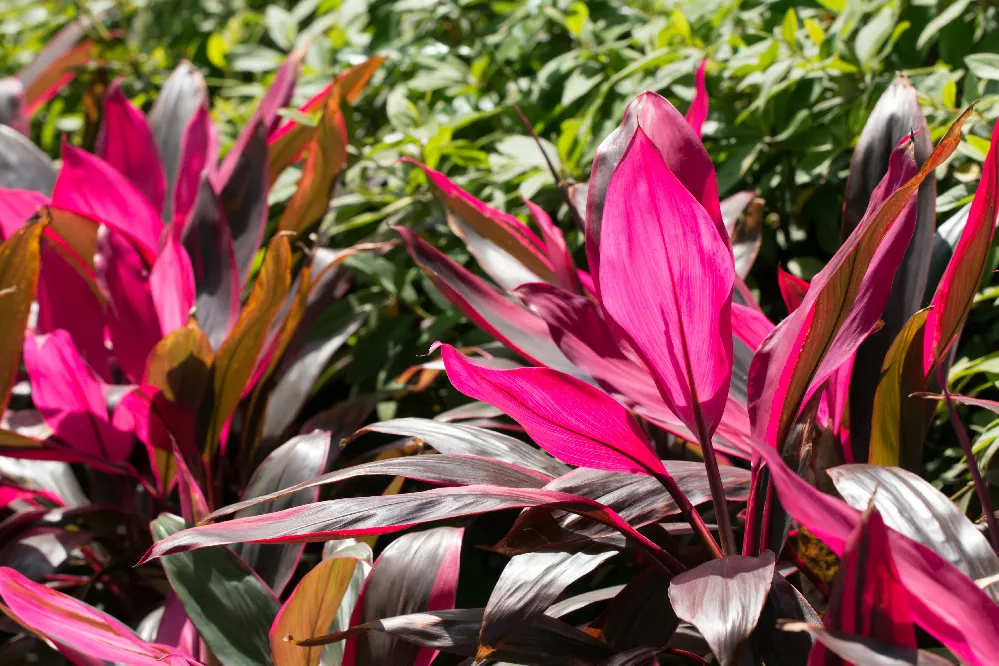Hawaiian Ti Plants for Sale - Buying & Growing Guide
Shipping Details:
Once your order is shipped, you’ll receive an email with a tracking number and estimated delivery date. Most orders ship immediately, but some items are seasonal and may only ship in spring or fall. These products are noted on the website.
Hawaiian Ti (Cordyline fruticosa) plants are not from Hawaii, nor are they used to make tea. They are, however, beautiful foliage plants for your home, patio, or garden depending on where you live. The foliage is available in a variety of colors, ranging from basic green to yellow and green, chocolate and green, pink, and even a brilliant red. You might enjoy growing a Hawaiian Ti plant for any of the following reasons:
- It has beautiful foliage, perfect for perking up an office or living room.
- Although perhaps not a beginner plant, it is relatively low maintenance.
- It can be grown as a tree in warmer climates.
Plant Care
Sunlight

Partial shade is best, but this plant can withstand both full sun and full shade.
Watering
Don't allow the soil to become too wet or too dry. Maintain consistent moisture by watering every other week.
Fertilizing

Fertilize once per month with a balanced, all-purpose fertilizer.
Planting and Care
Planting instructions
Hawaiian Ti plants are relatively easy to care for. They like a well-drained, loose soil with good loam content. Add coarse material to the bottom of the pot before adding the potting medium to help keep the drain holes open, especially if you are using a pot with low breathability, such as plastic or glass reinforced concrete. Ti plants prefer low to medium light, as a rule, but during certain seasons some varieties might need a higher light level. If you live in an area where temperatures are above 50 degrees Fahrenheit most of the time, the Hawaiian Ti plant can be a charming, low-growing tree for your garden.
While not an absolute beginner plant, they don’t present many challenges for a moderately experienced gardener or houseplant grower.
Watering and nutrients
Ti plants should be watered once per week or every other week — just make sure the soil is never dry or overly moist. Also, you should ensure that the pot is draining completely, since like many tropical plants, Ti plants are susceptible to root rot.
Ti plants can be fertilized with a liquid or slow release fertilizer, at about half of the normally recommended strength. The plant food should be applied about once per month during the spring and summer, allowing the Ti plant to rest during fall and winter. Avoid using any fertilizer or water that contains fluoride, since Ti plants are extremely sensitive to it.
If possible, water all house plants with distilled water or ordinary rain water to avoid problems that can arise from the chemical additives in city tap water supplies.
Pruning
Your Hawaiian Ti plant doesn’t necessarily need pruning, but cutting off the top or tips of branches can make it put out additional branches. This creates a bushier appearance, which can be a perfect solution for cultivating a lush container plant. They can grow up to ten feet tall and five feet wide if not pruned.
When pruning, clean your trimming shears using Lysol or Pinesol. Avoid using bleach, as it can damage the metal of your shears. Cleaning shears between cuts can help prevent spreading any kind of disease from one part of the plant to another.
Pests, diseases, and animals
One of the reasons that Cordyline fruticosa is not a good beginner plant is because it is susceptible to a wide variety of pests and diseases. Like many plants that are grown as houseplants, they are susceptible to fungus gnats, thrips, mealybugs, scales, and mites.
It’s also susceptible to erwinian blight, a bacterial infection, and fusarium leaf spot, which is a fungus.
The best way to keep your plants free of pests and infections is to avoid introducing any plants that might have problems, and to use good indoor gardening practices such as appropriate watering and feeding, as well as paying attention to light levels.
It should be noted here that Hawaiian Ti plants are poisonous for dogs and cats. If you suspect that your furry companion has been snacking on your leafy companion, it’s a good idea to get your pet to your local veterinarian as quickly as possible.
Light
If you have planted your Hawaiian Ti plant outside, then it will benefit from a mix of shade and bright direct light. However, when grown as a houseplant, the Hawaiian Ti plant enjoys bright light, out of direct sunlight. The exception to this is green-leafed varieties, which thrive indirect light. Other colors of the Hawaiian Ti plants can suffer burn on their leaves when indirect light, so if your plant lives on a windowsill, be sure to filter the light with curtains or window blinds.
Humidity
As a tropical plant, the Hawaiian Ti plant enjoys high levels of humidity. To replicate this inside, frequently mist your plant with a water misting spray bottle. Another way to create humidity is to place the plant pot on a tray of pebbles surrounded by water. As the water evaporates, it will create a more humid environment for the plant. Alternatively, use an electric humidifier. Although Hawaiian Ti plants thrive best in humid atmospheres, they will do just fine in lower levels of humidity as long as the air is not very dry.
Temperature
This plant does well with temperatures ranging from 65-80º F. It will struggle if the temperature drops below 60º F and should be kept away from cold draughts. If you keep your plant on a windowsill or near an external doorway, make sure your move it to a more protected area during colder seasons so as not to let it get too cold.
Propagation
Hawaiian Ti plants can be grown from cuttings. The cut ends can be dipped in a rooting medium, but it is not essential. Simply place a stem cutting from a young, healthy plant in a glass of clean, fluoride-free water and wait for the roots to appear. Change out the water every day or two to keep it fresh. If desired, you can speed the process by stirring in a small amount of liquid fertilizer, but it is not necessary. Alternatively, you can place the cutting horizontally in earth and keep it watered.
Ti plants can also be grown from seed. Place a ripe berry into potting soil, moisten, and wait. If you have planted several seeds, or a mash of berries, separate the young shoots into separate pots as soon as the secondary leaves appear.
Flowers
The Hawaiian Ti plant sometimes produces flowers, and more commonly when grown outside. The flowers appear in clusters in shades of pink or white and are very fragrant. The flowers are quite small, usually around half an inch in width. The plant also produces fruit in the form of red berries.
Repotting
While the plant is in its early years, it will need to be repotted once every two years, once the roots have filled the current pot. Carefully remove the plant from its current pot and place it into a slightly bigger pot where it will have more growing room, and cover the roots in a light loam-based soil. Once the plant reaches maturity, it will need to be repotted less frequently, around every four years. During the time in between repotting, you can also change the topsoil in the plant pot to maintain the health of the plant.
Outdoor planting
If you wish to grow your Hawaiian Ti plant outside, plant it during spring so that it has enough time to become strong before winter approaches. To plant in the ground, dig a hole roughly twice the width of the root ball and add some compost to sit the plant on. To ensure good drainage, you could add some horticultural grit, as the Ti plant does not like to sit in wet soil. Place the plant in the hole, cover it over with soil, and water fairly heavily. Once mature, the plant should do well without too much attention and will not need any physical support to steady it.
If planting in a container pot outside, use compost that is loam-based, and horticultural grit to aid in good drainage.
Outdoor care
For Hawaiian Ti plants living outside, it may be necessary to provide some winter care to help protect them from winter damage. Collect the leaves upward and secure them together using a soft fabric. This will protect the leaves from harsh winds and will also prevent water from sitting on the crown of the plant and rotting. In especially cold areas with little shelter, you may want to wrap the plant up in fleece. This will help to prevent damage from frost or snow. If your Ti plant is in a container pot, you should move it indoors or to a greenhouse during colder months. If this is not possible, wrap the plant in fleece and shelter it against a wall or fence to help protect it from winter damage.
Common Problems
Spotted leaves
Spots can appear on the leaves of Ti plants when they are stressed or have been physically damaged. When living outside, this usually happens as a result of cold wind, snow, or heavy rain. To prevent this, you may need to bring potted Ti plants inside for the winter months or provide some winter protection outside with temporary shelter or covers.
Leaf drop/ yellow or brown leaves
Ti plants suffering from foliage discoloration or leaf drop are usually a result of improper growing conditions. As jungle plants, they prefer warmer temperatures and high humidity, though too much heat will cause similarly troublesome conditions. If your Hawaiian Ti plant is suffering from these symptoms, try to increase the humidity with regular misting sprays or by using a humidifier, especially in dry seasons. You may also find that your Ti plant struggles to grow if it does not experience good levels of humidity or if it is allowed to get too cold or wet during winter.
Slime flux
This condition occurs in outdoors Ti plants following a particularly bad winter, producing a foul-smelling, slimy liquid. The problem is caused by two things: initially, frost damage can cause ice to form in the stem and root vessels, which results in damage to the tissue. The damage then provides entryways for the second problem, bacteria. Bacteria, which usually live harmlessly in the nearby soil, access the plant through the frost wounds. When spring comes around the sap in the plant rises, it becomes fermented by the bacteria and bacterial slime flux sets in.
Young Ti plants are at most risk from frost damage, though it has been known for frost to destroy mature Hawaiian Ti plants beyond repair. To identify frost damage, look for rotting on the stem of the plant where frost has invaded the tissue. The center of the plant where leaves grow from can also become brown and rotten. Another sign of frost damage is a pile of fallen leaves on the ground surrounding your Ti plant, along with floppy and wilting leaves.
Slime flux is even easier to spot, with an oozing, smelly liquid appearing on the stem of the plant. The liquid may be orange in color and can create patches of black staining on the stem.
There is no cure for bacterial slime flux, though, fortunately, it is rarely a death sentence for the Ti plant. If your plant falls victim to slime flux, you can scrub away the slime to try to reduce the smell and help with the appearance of the plant, though there is nothing you can do to remove the slime completely without cutting down the plant. If the slime is severe, you may wish to prune the plant right back down to its trunk, allowing it to regrow in the summer. Depending on the positioning of the slime, it may be necessary to cut the plant back down to ground level, where new shoots should sprout in late summer (Royal Horticultural Society).
Protection from frost damage is your best bet to prevent slime flux from reoccurring. Collect your Ti plant’s leaves up to the center in an umbrella-like fashion, and cover the whole plant with several layers of fleece fabric. This should help to prevent frost damage during exceptionally cold months, but it is not a failsafe solution.
Toxicity
The Hawaiian Ti plant is poisonous to dogs and cats when ingested. It contains toxins called saponins, which can result in symptoms such as vomiting, lack of appetite, and low mood. If you become aware that your pet has eaten some Ti plant, take them to a vet quickly for evaluation, where the animal may need medication to help them recover. Though the plant can produce unpleasant symptoms when ingested, it is not known to be fatal.
The plant is not toxic to humans and can be eaten when cooked.
Hawaiian Ti Plant Varieties
There are many varieties of the Cordyline, which all fall into the category of Ti plant. Some of the most popular are listed below.
Cordyline australis- ‘Red Star’
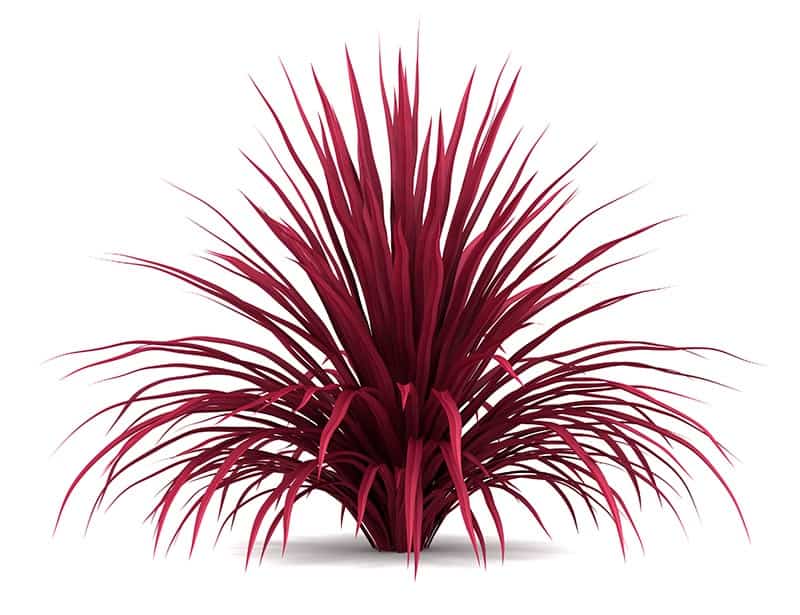
This plant features long burgundy sword-like leaves and enjoys lower humidity and dry conditions. When grown outside, it produces small white flowers. This Ti plant works particularly well outside in planters and suits a minimalist style garden display.
Cordyline pumilio- ‘Dwarf cabbage tree’
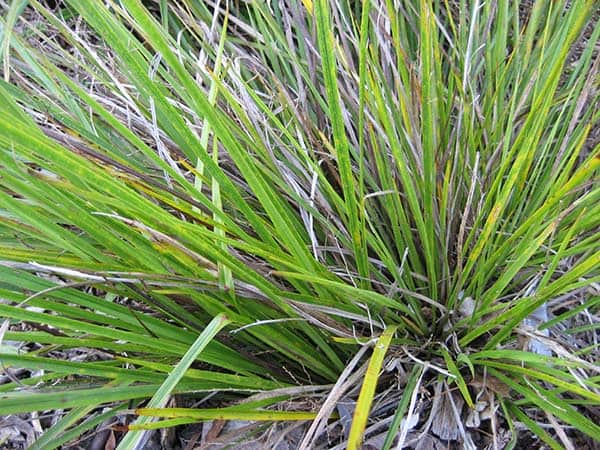
Unsurprisingly, this Ti plant is one of the smallest varieties, growing up to a maximum of around three feet. It originates in New Zealand and is grown primarily as a food crop for its ability to add sweetness to foods.
Cordyline electric pink
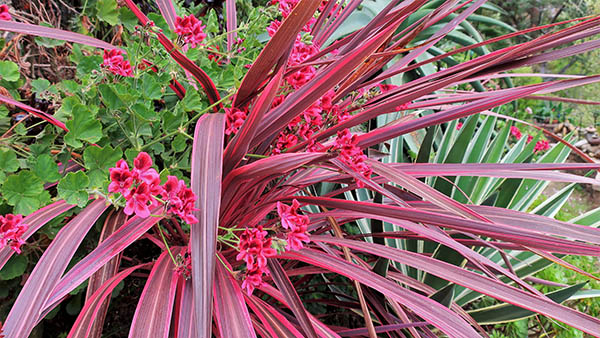
This striking pink plant was produced from a mutation of another Ti plant, the Cordyline banksii. It is extremely popular in outdoor gardens because it is very tolerant of an array of conditions, able to survive even extreme temperatures once matured. The vivid pink leaves make this plant an ideal centerpiece in the design of a garden, adding color to the landscape all year round.
Cordyline firebrand
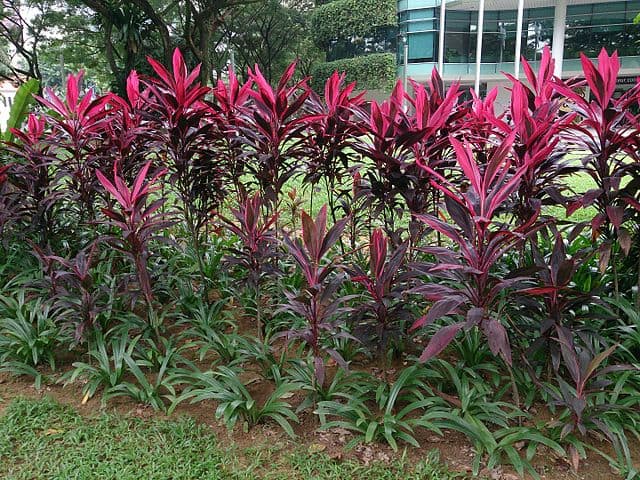
This plant features pale veins and leaves in a purple/red color. It is also sometimes called the Red Dracaena.
Cordyline tricolor
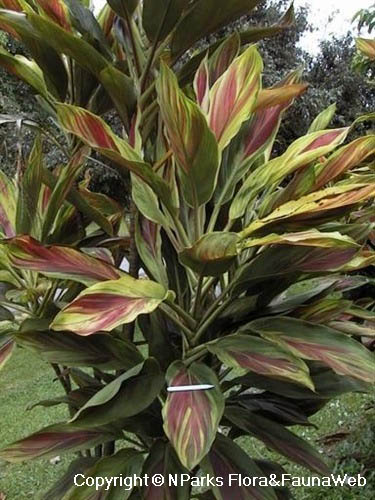
This plant’s leaves are streaked with bold splashes of pink, green, and yellow.
Cordyline baptisii
The leaves of this Ti plant are pink and yellow-streaked.
Cordyline amabilis
This plant features leaves with white and pink spots.
FAQs
How long does it take for a Hawaiian Ti plant log to grow?
What is the best place to put my Hawaiian Ti plant?
Your Hawaii Ti plant, Cordyline fruticosa, will enjoy an area with a medium light level, where it can be warm and free from drafts. Avoid placing it too near a window as this might burn the leaves or allowing it to become chilled at night. But do allow it to get plenty of indirect sunlight.
How often should I repot a Hawaiian Ti plant?
Ti plants should be repotted about once every two years. If your Ti plant has roots growing out the drain hole, seems to require more frequent watering, or is top-heavy and seems to fall over, then chances are it needs to be repotted. Locate a container that is about three inches bigger around than the previous one. Add coarse gravel over the drain hole, then a layer of new potting medium. Gently ease your plant out of its old container, then settle it into its new home. Tuck in additional fresh potting soil, and water to settle it in.
Compare Similar Products
Customer Reviews
 Color is very pretty but ...
Color is very pretty but ...I love the color . The plant itself was a bit beat up ( holes in leaves) and kind of bent but I am hoping it looks like the picture ... soon
 Overall Review
Overall ReviewOverall...we are fairly pleased. We ordered two plants and one was in extremely rough shape upon delivery. We are trying to nurse it back to health. The other plant was in great condition, as were all our other previous orders from your company.
